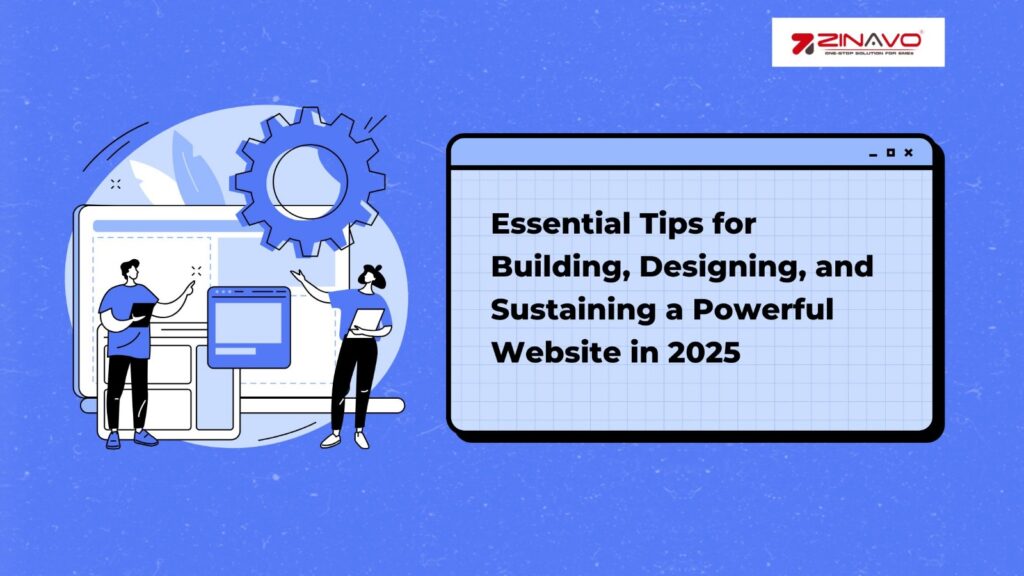Essential Tips for Building, Designing, and Sustaining a Powerful Website in 2025
Introduction
An effective website is more than just an online presence, it represents your brand, facilitates customer interaction, and leads to business success. Whether your website facilitates bookings, provides information, or drives sales, it needs to be functional, attractive, and well-maintained. Here’s a guide for designers, developers, and business owners to ensure your website stands out and remains impactful.
For Designers and Developers: Building a Standout Website

- Design Elements: Create a Lasting Impression
- Unique Layouts: Stay ahead by exploring trending design concepts such as asymmetry, 3D elements, and bold gradients. Your pages will be more interesting and engaging as a result of these.
- Custom Graphics: Incorporate bespoke illustrations and visual elements tailored to your brand. Personalization enhances the authenticity of your site.
- Typography Matters: Select fonts that represent your brand. Typography can leave a lasting impression on visitors, reinforcing your identity.
- Aesthetics: Build a Cohesive Visual Appeal
- Color Strategy: Use a consistent and meaningful palette that aligns with your brand’s message. Experiment with gradients and complementary hues for a modern touch.
- High-Quality Imagery: Incorporate optimized, cohesive visuals that narrate your brand story effectively. Avoid stock photos that feel disconnected.
- Development: Ensure Seamless Functionality
- Responsive Designs: Create a website design that is compatible with all devices (desktop, tablet, and mobile). Broken links or misaligned visuals can harm the user experience.
- Speed Optimization: Minimize loading times by compressing images, reducing unnecessary scripts, and streamlining code for peak performance.
- User Experience (UX): Keep It User-Friendly
- Simplified Navigation: Structure menus logically and provide clear pathways for users. Ensure animations and transitions are smooth yet functional.
- Accessibility Features: Design inclusively, catering to all users, including those with disabilities. Consider tools like screen readers and keyboard navigation.
- Interactive User Interface (UI): Engage Your Audience
- Dynamic Elements: Use engaging features such as hover effects, sliders, and buttons. A balance between simplicity and interaction is key.
- Visual Hierarchy: Organize content strategically, placing the most important information where users naturally look first.
For Business Owners: Sustaining a Functional Website

Once your website is live, maintaining its relevance, security, and performance is important for long-term success.
- Implement Advanced Security Measures
Shield your site from threats with robust security protocols like firewalls, two-factor authentication, and content security policies. Partnering with an expert team can make this process seamless. - Prioritize User Experience (UX)
Ensure your website is up-to-date with the latest technology trends. A clean, intuitive layout encourages visitors to explore, increasing the likelihood of conversions. - Regular Backups
Protecting your data is paramount. Schedule backups frequently to safeguard against data loss caused by technical failures or cyberattacks. - Software Updates
Outdated software can make your site vulnerable to attacks and malfunctions. Keep your CMS, plugins, and themes updated to maintain security and compatibility. - Content and SEO Optimization
The importance of fresh content for engaging visitors and improving search engine rankings cannot be overstated. Regularly update blogs, product pages, and metadata while ensuring SEO best practices are in place. - Performance Monitoring
Regularly track your website’s performance, including load times and server response rates. Identify bottlenecks and address them swiftly to ensure a smooth user experience.
Conclusion
The foundation of a successful online presence is a well-designed and properly maintained website. By combining aesthetic appeal, user-centric functionality, and proactive maintenance, you can keep your website competitive and relevant. Stay updated with design trends and technological advancements to ensure your site remains a powerful tool for your business. Regularly update your content to ensure its relevant and up to date. Monitor your website for errors and security issues. Regularly review your website analytics to measure its performance.



